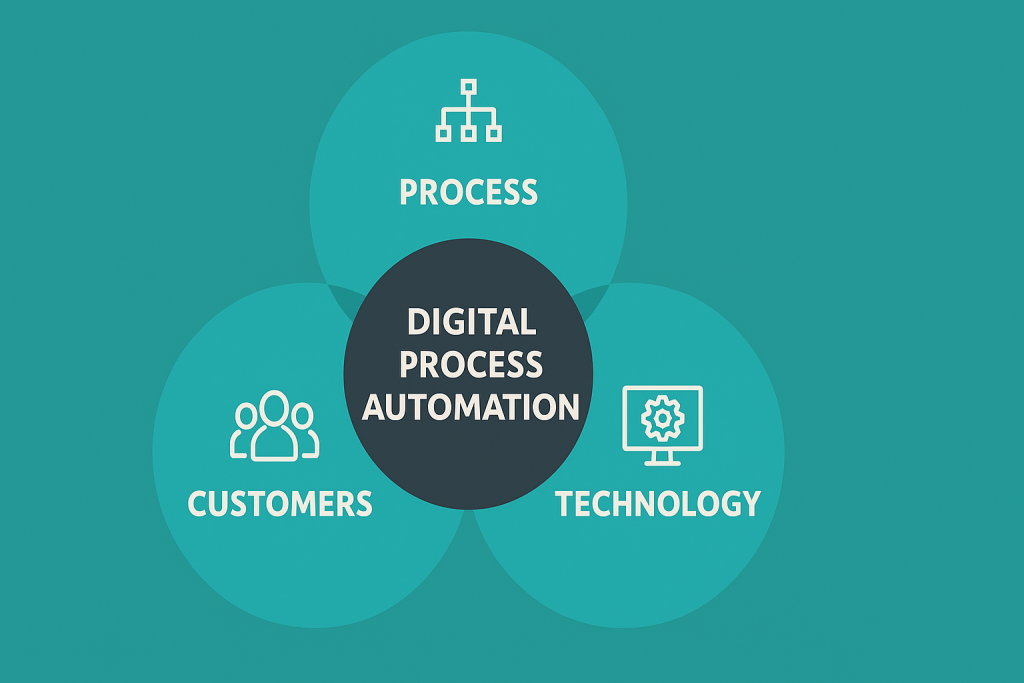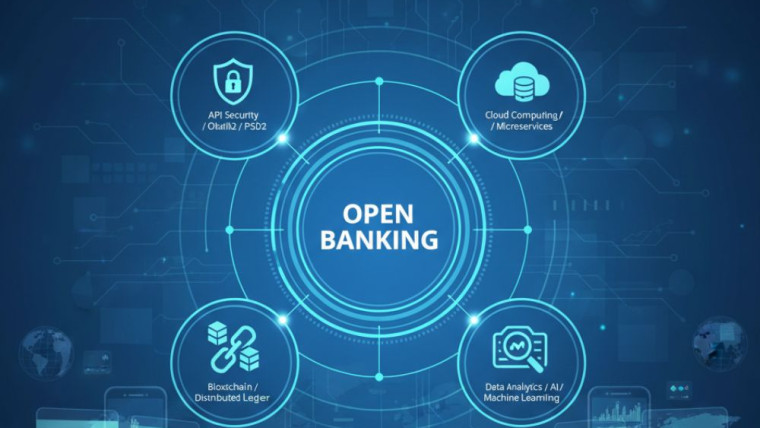Digital transformation is reshaping industry. However, the financial sector is no different. Besides being a basic driver of greater efficiency and higher customer satisfaction, Digital Process Automation (DPA) is one Of the most important. Yet just what is DPA What does this mean for A New Age in Banking? This blog post will answer all your questions, help you comprehend its concrete applications and benefits, and tell why taking away DPA can be deadly to a modern financial institution. Digital Process Automation (DPA) is playing a vital role in financial industry modernization. It’s also a new approach to developing apps, bases software design around people rather than on static data services. But what in the world is DPA, and how does it differ from traditional conventions? This blog aims to make things easy: tell you what DPA is all about, then show you some good examples of its use. It will also explain in simple terms–without getting technical or using too much jargon–the reasons for firms that want to keep up must employ DPA.
What is Digital Process Automation
Digital process automation (DPA) describes the use of technology to streamline, optimize and automate tasks in a company’s processes. It takes its origins from traditional business process management (BPM) but actually takes things to the next level, adding unique characteristics and new-age technologies like artificial intelligence (AI), machine learning (ML) and robotic process automation (RPA) as well as analytics.

DPA is not just about basic automation but optimizes and improves end-to-end workflows, making processes both automated and intelligent, integrated, seamless and customer centric. This makes it especially valuable for industries like financial services, where complex processes, regulatory requirements and a commitment to exceptional customer experiences come together.
Why Financial Services Need Digital Process Automation
Industry Challenges
The financial services sector is notorious for its complex and heavily regulated ecosystem. Institutions face several challenges:
- Paperwork Overload: Traditional banking and financial services still rely on manual paperwork, slowing operations.
- Regulatory Compliance: Constantly changing regulations make it challenging to manage compliance without error.
- Customer Expectations: Modern consumers demand quick, personalized, and seamless services.
- Cost Pressures: Rising operational costs strain profitability unless efficiency is drastically improved.
Enter Digital Process Automation
Digital Process Automation directly addresses these challenges by creating smoother workflows, reducing errors, and providing personalized, scalable, and cost-effective solutions. For example, using digital automation, a bank can automate loan approval workflows, significantly reducing the time it takes for customers to get the funds they need.
Core Applications of DPA in Financial Services

Automating Customer Onboarding
Customer onboarding, often plagued with tedious paperwork and lengthy approval cycles, is one of the crucial areas improved by DPA. It allows institutions to:
- Validate customer documents using AI-powered verification systems.
- Automate Know Your Customer (KYC) compliance.
- Seamlessly integrate with Customer Relationship Management (CRM) platforms for better service.
For instance, a digital bank using DPA can onboard a customer within minutes by automating ID verification and performing instant credit checks.
Enhancing Loan Processing
Loan processing traditionally involves multiple checks, lines of approval, and verification, stretching timelines to weeks or even months. With DPA:
- Data collection from applicants is automated using digital forms.
- Credit check processes integrate seamlessly with third-party systems for real-time results.
- Loan approval decisions are streamlined with ML algorithms predicting applicant credibility risks.
The result? Faster loan approvals, happier customers, and reduced manual intervention.
Strengthening Fraud Detection and Compliance
Fraud is a significant concern in the financial world. Digital Process Automation paired with AI and analytics can:
- Monitor and flag suspicious transactions in real-time.
- Ensure compliance with anti-money laundering (AML) regulations.
- Provide detailed audit trails to simplify regulatory reporting.
For example, DPA-enabled fraud detection systems use machine learning to analyze customer behavior and alert institutions to activities deviating from typical patterns.
Streamlining Claims Processing
For financial segments like insurance, claims processing is a manual-intensive, time-consuming operation. DPA simplifies this fundamental process by:
- Automating claim intake through online portals.
- Standardizing claim assessment and verification protocols.
- Triggering automated communications to keep claimants updated.
This not only reduces claim settlement times but also elevates customer satisfaction.
Improving Personalized Customer Engagement
Digital Process Automation helps financial service providers deliver highly personalized experiences. By leveraging AI and rich data analytics, banks and insurance firms can:
- Offer targeted product recommendations based on customer profiles.
- Send personalized reminders for payments or contract renewals.
- Tailor marketing campaigns based on individual financial goals.
Personalized engagement facilitated by DPA fosters stronger, long-lasting customer relationships.
Benefits of Adopting Digital Process Automation

Financial institutions that implement Digital Process Automation benefit in several ways:
Operational Efficiency
By automating repetitive tasks and optimizing workflows, DPA drastically improves overall efficiency. Employees can focus on more strategic, high-value activities, such as innovation and customer relationship management.
Cost Savings
Automation reduces manual intervention, mitigates errors, and accelerates processes, all of which lead to reduced operational costs. For example, automating claims processing can cut down administrative expenses by 30% or more.
Enhanced Customer Experience
Speed and personalization are what customers value most. With DPA, financial institutions can reduce turnaround times, offer tailored experiences, and respond to queries faster, ultimately enhancing client satisfaction.
Regulatory Compliance
Keeping up with evolving regulatory requirements becomes less daunting when DPA is in place. Automated compliance management eliminates errors, introduces transparency, and ensures timely submission of essential reports.
Better Scalability
As financial institutions grow, manual processes often struggle to keep pace. DPA provides scalability, allowing systems to handle higher workloads without added effort or escalating costs.
How to Implement Digital Process Automation in Your Organization
If you’re considering integrating DPA within your organization, here’s a step-by-step guide:
Step 1: Assess Your Needs
Start by evaluating which processes have the highest cost and time inefficiencies. Prioritize areas where DPA can deliver the strongest ROI, such as loan processing or claims management.
Step 2: Choose the Right Tools
Not all automation platforms are created equal. Look for DPA solutions with capabilities that meet your specific requirements, such as AI-powered analytics or seamless system integrations.
Step 3: Start Small
Begin with a pilot project to test the application and impact of automation on a specific process. Use the insights gained to refine your approach and scale up gradually.
Step 4: Train Your Teams
Introduce training programs to familiarize your employees with new tools and technologies. Ensuring they understand the benefits of DPA will make adoption smoother and more successful.
Step 5: Monitor Progress
Track the performance of implemented solutions by measuring KPIs such as process completion times, error rates, and customer satisfaction scores. Regular evaluations will help you optimize outcomes.
Gaining Competitive Advantage With DPA
Digital Process Automation is no longer just a buzzword; it is indispensable for financial institutions that intend to remain competitive in the rapidly changing market altogether. This way, banks, insurers, and other financial service providers can work like they have never done before. They not only become inefficiency machines bdrought up on percent-off coupons from a different age, but also design superior customer experiences and future-proof their businesses.
Are you ready to take your financial organization to the next level? Consider how DPA revolutionizes processes and changes the view customers have of you as a business.








How Open Banking APIs Are Revolutionizing Digital Finance?
What Is Digital Faxing for Financial Institutions
Open Banking Revolution: Transforming Digital Finance and Empowering Consumers
Digital Twin Technology in Finance: How Virtual Models Are Transforming Risk Management
Digital Twin Technology in Finance: How Virtual Models Are Transforming Risk Management
The Future of Personal Finance: Autonomous Finance and AI Money Management
AI Credit Scoring: Revolutionizing SME Banking and Digital Loans
AI Fraud Detection: How Banks Prevent Financial Crime in Real Time